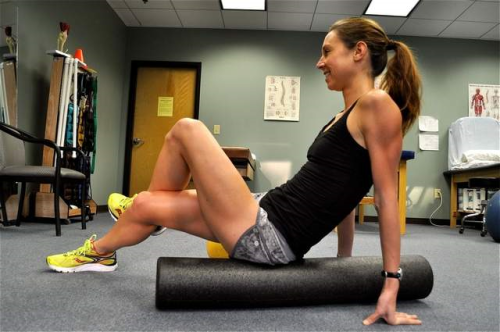I have always been a big fan of using foam rollers and trigger point tools to help with stubborn knots and irritated muscles. Stretching is good but with stretching it’s only really effective when the area you are targeting is warm. Stretching cold is probably one of the most unproductive things you could ever do. With foam rolling it’s easy to do and is a great way to warm the muscle up while getting the therapy done at the same time. Another really cool thing about foam rolling and trigger point therapy is that there are so many different variations you can use. Different design and size rollers along with different stiffness and size of trigger tools can really be helpful when you’re trying to hit those hard to reach areas.
The goal for this article is to go into a little more depth with the treatment of what could be an irritated and overworked Piriformis. I’m going to show you how to use a foam roller and various trigger point tools to relieve a lot of the pain you may be experiencing in your Piriformis.
Oh, before we jump in. I took a snippet from one of my F4BP Private Coaching sessions (on the topic of mobility and tissue release) and wanted to give you free access only through this article. I know this bonus content will really make this article 10x more impactful while you navigate your tight Piriformis. You can pick it up below!
Okay you have everything you need! Let’s dive in!
How does trigger point work?
Think of the trigger point tool, in this case, a tennis ball, as a stop and start switch. When used properly the trigger point tool is placed in a way that when pressure is applied it almost completely shuts off blood flow into that affected area. This sounds bad but it’s actually helping the healing process. After about 45 seconds of pressure, the ball is removed and fresh oxygenated blood rushes into the affected area. Repeated steps of this pumps fresh blood over and over into the area delivering the essentials to repair the damaged tissue. In most cases direct pressure on the affected area may be a little painful. This is where upstream and downstream work comes into play. Upstream and downstream is referring to the location of the trigger point tool in comparison to the affected muscle. For example, the Piriformis is a pretty small muscle so if it’s over irritated, putting pressure directly on to the muscle may hurt pretty bad. Starting above or below (upstream or downstream) from the muscle helps condition the area to receive what you’re trying to do. It’s not uncommon to work from the outside in when dealing with an injury.
Not all trigger point tools are created equal. For starters using an old tennis ball compared to a brand new one will make a difference in firmness. If you know the area is super sensitive then start with the smallest and softest ball you can find. In this case, my top choices are racquet balls or tennis balls. Once you have developed a tolerance to the pressure you can dig a little deeper in certain areas using things like a golf ball, lacrosse ball or even a softball. Choose your tool wisely and don’t overdo it!
How does foam rolling work:
Think of it this way: The knot in the middle of this rope is your troubled area. If you were to pull on either end of this rope what will happen to that knot? It may get smaller but it becomes even more tighter and bound up. This is how I describe stretching (in situations where stretching only makes things worse). When you foam roll you are actually rolling over that knot over and over pumping fresh blood in and out of the area with every roll. Eventually, that knot is going to work itself open to where the pain is no longer there.
If you have a hyper sensitive area you are trying to work such as an irritated Piriformis the foam roller will allow you to work over the entire muscle before you dive in head first with the lacrosse or tennis ball. It’s as if it is prepping the area to relax and loosen so that you can get into the tough spots with less irritation. You never want to just jump right in with some of these treatments. If the area isn’t warmed up enough digging in with trigger point therapy could cause a reverse reaction where it becomes even more irritated. The type of foam roller will vary on your tolerance. For starters. you can pick up your basic foam roller from any sporting goods store or even Amazon! Once you have built up some tolerance you can move on to a stiffer roller or even what is known as a rumble roller. These are awesome! It’s like getting the foam rolling benefit along with the trigger point massage at the sane time! This is a link to pick one up Rumble Roller (Affiliate link). All in all these two techniques trump stretching by itself. You can get into those hard to reach areas and the best part about this style of treatment is you can do it by yourself. It all operates on your body weight.

When is the best time to do the foam rolling and trigger point work?
To get the most out of the time you spend using these tools you want to do them after the body has warmed up. My top 3 times would: 1) After your workout. Remember you can do these as a part of the warm up before the workout but don’t rely on that to cover your bases. Spend an extra 10 minutes after your workout hitting your trouble spots. 2) After my salt bath/ Magnesium Oil application. Another great time to put these tools to work is after the body has been soaking in a hot tub. This allows your body to be relaxed to where you can get the most out of each exercise. 3) After a hot shower. This is similar to the bath technique. You basically capitalizing on the hot water soak to warm up the joints and muscles.
Do these drills for at least 15-20 minutes every day. If nothing else, focus on these drills specifically!
My top trigger point massage exercises for the Piriformis.



My top Piriformis foam rolling exercises.


If you’re looking to pick up the exact soft tissue tools I use I will link them below one more time! In case you don’t get down with them, these links are affiliate support links.
This is my favorite Rumble Roller of the bunch. Be careful about knock off versions. The stiffness of these nodules have lasted years compared to other that seem to have lost there stiffness after a while.
You can’t go wrong with a solid Lacrosse Ball. I have about 4 of them myself along with softballs and tennis balls. Pick up a few and keep one at your office, one in the car and one at home.
Thanks for stopping by make sure to share it with your friends and family!
Which technique above do you like the best OR do you have a better one no listed? Let me know below!
Your Coach,
William




My right leg is weak from status post 2 laminectomies in 6 months and besides Piriformis and gluteus Maximus pain, it is hard to get down, up, and hold myself up while doing the exercises. Any suggestions PLEASE. I’m 63, average weight and a farm girl so usually not a weakling and I’m getting depressed from all this! It seems everyone’s videos are with young healthy people. Please help me.
Hey Cindi,
You can try these standing up against a wall! Essentially it is the same thing but now the wall is the “floor” that you are pressing into.
Try that out and let me know!
William
I have had tight glutes and hips for years , is it possible that the tightness could effect all the muscles all the way up my back even around by lats ?? I seem now to notice if I get my hips loose most of that pain is relieved. I have been to countless doctors even to Mayo trying to get relief , worth a shot , Thanks !!
Hey Jeff!
Absolutely. This is where the phrase “Chasing Pain” comes from. The pain/symptoms will float around causing you to constantly be treating different things. What does your exercise routine look like? A lot of this can be solved through strategic corrective exercise and strength training.
William
Any thoughts on how to eliminate or at least decrease frequency and intensity of nighttime cramping d/t lumbar radiculopathy?
Hey Jim,
Would need to know a lot more of your background to even come close to what would be a worthwhile piece of advice.
What is “fresh blood”? Sounds good, but is it really a thing? Any science behind this?
Hey Chris, I chuckled when I read this comment because of how stupid I sound writing that. It’s not literally “fresh blood” It’s just oxygenated blood. Its the same idea when doing things like trigger release or using floss bands. It restricts the blood flow to an area then you release the hold so “new” or oxygenated blood can make it’s way into the area. It helps force the unwanted toxins from the area and allows healing to happen. Make sense?